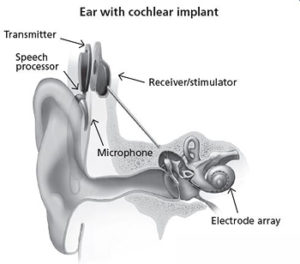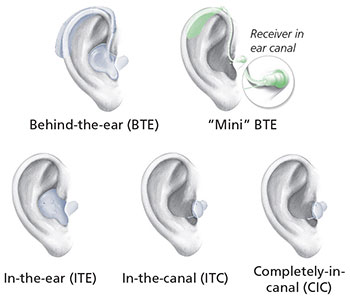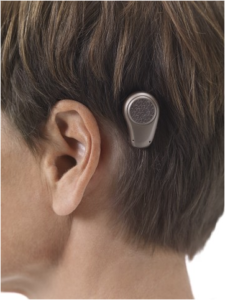Both hearing devices help people hear.
Some individuals with hearing loss use amplification devices to hear the sounds in their environment. Two main types of amplification devices are hearing aids and cochlear implants.
Quick note at the outset: whether or not to get a hearing aid or cochlear implants is a complicated decision that is best to discuss with an audiologist and/or otolaryngologist (learn about these jobs here). These experts can help families decide if a device may be the best option for them. Also stay tuned for a future post on sign language!
Hearing Aids
Hearing aids work by making sounds louder so the inner ear can detect them. The device is made of three parts: a microphone, an amplifier, and a receiver. The microphone picks up sound waves from the environment, converts them into electric signals, and passes them to the amplifier. The amplifier makes the electronic signals stronger and passes them to the receiver. The receiver turns the amplified signals into louder sounds, and plays the sounds into the ear. The hair cells in the inner ear picks up these louder sound waves and sends them to the brain. (Learn more about how hearing works here!)
Digital hearing aids can even change which sounds are amplified based on the person’s needs (ex: high pitched sounds can be amplified more). Typically, the microphone and amplifier are behind the ear, and the receiver sits in the ear canal, but there are many options.
Another kind of hearing aid is called a bone-anchored hearing aid (BAHA), which sends amplified sound vibrations to the inner ear through the bones in the skull. This is surgically placed, and is used by people who are born without an ear canal or with other conditions that make traditional hearing aid options less-than-ideal.

“It takes time for the brain to adapt and learn to recognize the electric signals as sound.”
Cochlear Implants
Unlike hearing aids, cochlear implants work by skipping the hair cells in the inner ear. The cochlear implant does not rely on having working hair cells in the inner ear because it sends signals directly to the auditory nerve. Part of the cochlear implant sits behind the ear, and part of the cochlear implant needs to be inserted surgically. These two halves communicate wirelessly.
Cochlear implants have four parts, which work together to send information directly to nerve cells: a microphone, a speech processor, a transmitter/stimulator, and an electrode array. The microphone takes in sounds from the environment, the speech processor arranges the sounds by how high or low pitched they are, the transmitter/stimulator sends the processed sounds and converts them to electric signals, and the electrode array sends the electric signals to different parts of the auditory nerve based on the pitch of the sound.
Hearing using a cochlear implant is still different from having normal hearing, and it takes time for the brain to adapt and learn to recognize the electric signals as sound.
Some people may decide to get an amplification device on one ear or two – or to get a hearing aid in one ear and a cochlear implant in the other! Depending on the type of hearing loss, some people may even get a hearing aid and cochlear implant in the same ear. This is called a hybrid. In a typical hybrid, the cochlear implant sends electric signals for the high-pitched sounds and the hearing aid amplifies the sound waves of low-pitched sounds.

Erin Campbell
Author
Erin is a Ph.D. student in the Bergelson lab at Duke University, where she studies how young children who are Deaf or blind learn language.


